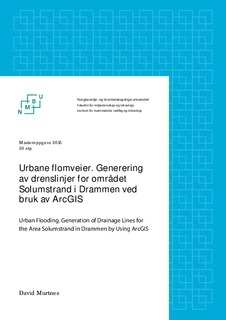| dc.description.abstract | Climate change in Norway presents new challenges that must be addressed. The last 150 years, the concentration of important greenhouse gases in the atmosphere has skyrocketed. This is mainly due to the anthropogenic industrial revolution. As a result the climate has changed. In the past 30 years, Norway has experienced increased average temperatures, increased rainfall and more extreme weather. Since levels of emission gases only continues to rise, this trend is expected to continue. Increased rainfall combined with increasingly densification of surfaces in urban areas has led to several incidents of urban flooding. Overloaded drainage systems are becoming a more common occurence. A large proportion of the water pipes were designed decades ago. They hardly foresaw the increased densification of surfaces and increase in rainfall and did not take this into account. This has led to increased flooding both in number and intensity over recent years. Flood damage has inflicted great cost on society and several disadvantages for those affected. For solving these problems, one must move away from conventional pipe systems and look towards greater use of open and local disposal of surface water (LOD). Before finding measures to deal with storm water, it is necessary to know how the existing pipe system works and which areas are most prone to flooding. This can be solved with models of reality. The knowledge you get from models can be used to prepare measures to reduce flood damage.
In this task, the software ArcGIS with extensions with "3D Analyst" and "Spatial Analyst" has been used to produce maps for flood vigilance for an area south of Drammenselva. The area is approximately equal to the delimitation of Solumstranda rensedistrikt. First, a digital terrain model in ArcGIS was created. Raw data that was used in the terrain model were LiDAR data (airborne laser scanning) and FKB data representing roads, buildings and water lines. The extension "Spatial Analyst" was used to generate drainage lines and sinks. Drainage lines show potential flooding roads and give a a good indication of flood-prone areas. The thickness of the drainage lines indicate the size of the watersheds draining into points in the drainage line. Sinks are depressions in the terrain where floodway may occur. The model is intended for a worst-case-scenario with winter flooding. It is assumed that the field is frozen so that all the water flows on the surface. Additionally, snow and ice prevents water from flowing down into drains. Therefore the drainage system is not included in the model. The caution map is a useful tool for land use planning. Since the caution maps in this task have not been verified against real flood values, it can not be used for this purpose.
The caution maps that were produced in this task were compared with the flood of pictures taken within the analytical area. It is not compared with the damage data. There turned out to be many similarities between the caution maps and flood pictures. Based on the comparison and visual observation, it appears that the caution maps are hydrological correct. In addition, the use of ArcGIS has proven to be user friendly for people without previous experience from the ArcGIS platform. | nb_NO |
